Creating the HS2 Learning Legacy
Learning Legacy has been used on major projects for more than 10 years to capture and share learning from major projects. It was first developed to share the learning from the London 2012 construction programme. Building on the success of the London 2012 Learning Legacy, Crossrail set up its Learning Legacy programme, followed by Thameslink and then High Speed Two (HS2).
This paper sets out how Learning Legacy has evolved from London 2012 and how the improvements have been integrated into the most recent HS2 Learning Legacy model. It describes the delivery framework and lessons learned for the implementation of a structured Learning Legacy for major projects. It will be of interest to other projects setting up learning legacies.
Background and industry context
Learning from experience is recognised as one of the Principles of Project Success published by the UK Government’s Infrastructure & Projects Authority (IPA)[1]. It states that projects should seek out experience from other projects and use it in planning and delivering their own project as well as capturing lessons throughout the life of the project and sharing them as feedback, stories and case studies to improve project delivery for wider public benefit. This requirement is also reflected in The Construction Playbook[2], the UK Government’s guidance for all publicly funded projects.
The Construction 2025[3] Industrial Strategy however identified a ‘lack of collaboration and knowledge sharing’ as a weakness stating that ‘learning points from projects are often team-based and lost when the team breaks up and project ends’. Whilst research undertaken by PMI put some tangible value to knowledge sharing, finding a 35% improvement in project outcomes by organisations that are most effective at knowledge transfer[4].
The London 2012 Olympics construction project was the first major project to set up a structured approach to the capturing and sharing learning for the wider public benefit through its Learning Legacy[5]. It captured lessons learned, good practice and innovation with the stated aim of raising the bar in industry and showcasing UK PLC. The Learning Legacy methodology has now been around for more than 12 years and applied by four major projects with each one contributing to the wider and continuous learning cycle in industry (figure 1).

Figure 2 below shows the timeline for the start of each major project’s learning legacy.

Learning Legacy was first implemented by the Olympic Delivery Authority (ODA) in 2011 to capture lessons learned, good practice and innovation from the London 2012 construction programme[5]. Over 600 learning resources were published and, working in partnership with industry/professional bodies, more than 50 dissemination events were held to share the learning more widely. This was the first project to capture intellectual capital on such a scale and was hailed by industry as a model for success:
“The ODA has provided a model for success that is transferable to other UK construction projects.”, Paul Morrell, Government Construction Advisor[6].
In 2014, Crossrail took the baton from London 2012 and started collating its learning legacy with the first set of content published on the Crossrail Learning Legacy website and launched at an industry event in 2016[7]. By May 2023, 840 resources had been published and 92 dissemination events and articles produced. The Crossrail Learning Legacy continued to be populated with content through to completion in 2023. A summary of the programme is detailed in one of the final learning legacy papers “Managing the Crossrail Learning Legacy” [8]
Building on this, the Major Projects Association when developing their Major Projects Knowledge Hub in 2016, included a key objective to act as a central hub connecting all learning legacies through a single portal[9]. This was significant as it meant that learning legacies could exist after the project had finished. It also meant that smaller projects could use the knowledge hub to publish their own learning legacies without the need to invest in a dedicated website.
In 2019 the Thameslink Programme adopted the same methodology to publish their learning legacy[10].
Learning Legacy was starting to become the industry standard for publicly funded projects to share their learning with the wider industry. It was no surprise then that HS2 would take the learning legacy baton next. The HS2 Learning Legacy started in 2020 with the first set of content published on the HS2 Learning Legacy website at an industry event in October 2021[11].
The ODA published the London 2012 Learning Legacy at the end of the project whilst Crossrail was 60% complete when it published the first tranche of content. HS2 started much earlier as, although 9 years in, it hadn’t yet started construction when it first sought to establish its learning legacy. Hence the first step was to consult across the organisation to establish whether there was an appetite to do a learning legacy and what this might look like.
Approach
Developing the HS2 Learning Legacy policy
Developing the policy for Learning Legacy was the first important step in setting up the HS2 Learning Legacy. It provided the mandate for the Learning Legacy.
All board members and the executive leadership team were interviewed and, without exception, all supported a learning legacy being established at HS2. This exercise helped identify an initial list of topics to focus on and ensured ‘buy-in’ and support across the whole organisation and the five policy principles were agreed[12]:
HS2 will:
- Support the aspiration for open knowledge – sharing within the boundaries of the security, commercial and reputational controls
- Be open – by including information and context necessary to understand the content of each Learning Legacy output
- Be transparent – in sharing where challenges were met, or actions taken did not work as planned, explaining remedial action taken and the eventual result, focussing on recommendations
- Limit redaction to security, reputational and/or commercial items that may represent a risk to the Programme or that are required to be redacted for Data Protection or other legal reasons
- Schedule publication of certain outputs to align with the HS2 programme constraints and any sponsor restrictions
The policy also identified the Executive Owner of the Learning Legacy as the Director of Communications and Stakeholder Engagement. The question of where Learning Legacy sits within an organisation is always a topic of debate at the beginning. At London 2012 it was in the Programme Assurance Office; in Crossrail initially, it was the Procurement team and latterly the Communications team. At HS2 it could have equally sat within the PMO or Innovation team – all being pan-organisation. HS2 recognised that the success of Learning Legacy relies on effective communications and stakeholder engagement, not just information and knowledge capture, and this was supported by an engaged and enthusiastic sponsor in the Director of Communications and Stakeholder Engagement.
Building on the experience from both London 2012 and Crossrail, the Learning Legacy Framework[13] and Implementation Plan were developed and approved by the HS2 Executive Leadership Team in January 2020.
The Learning Legacy Framework was organised into the four workstreams shown in Figure 3 below and described in the following sections.

Capture
Content types
Learning Legacy content can be categorised as:
- Insight: what worked well, what didn’t work so well and recommendations for future projects
- Data: documents and templates that have been used successfully on the Programme that can be ‘borrowed with pride’ by other projects
- People: the experts behind the delivery of the HS2 Programme
Lessons learned from previous programmes found that all three elements are required for the effective transfer of knowledge. London 2012 Learning Legacy focused principally on the Insight and People but, following feedback that users felt the detail was missing to enable them to apply it effectively, Crossrail published its Management System documents – processes, policies, procedures, etc – which (anecdotally) has increased its legacy value enormously.
Case study example
Working in the assurance team on the East Bank project for the London Legacy Development Corporation (LLDC), I was asked to set up the change control process. Rather than starting from a blank sheet of paper, I visited the Crossrail Learning Legacy website, downloaded the Change Control Procedure, read the insight from the Crossrail Change Manager and contacted him via LinkedIN with any questions I had. I then adapted the Change Control Procedure to suit the LLDC project context. This saved a significant amount of time and I could be confident that I was starting with a high-quality assured document. Karen Elson, Co.Cre8
Similar to previous learning legacies a set of templates and author guidance was developed for all types of content[14].
Sourcing content
For all the learning legacies to date, the type of content captured has been in a number of pre-defined formats. These are case studies, technical papers, micro-reports, good practice documents and videos. This allows for in-depth papers, shorter articles and videos as well as some of the ‘business as usual’ content from a major project that can be invaluable to the wider industry. In addition, research synopsis papers are also encouraged to capture the research and development being undertaken within the projects. This knowledge is often used within projects but not shared for wider public benefit. Team authorship was also promoted as well as individual papers. This provides an opportunity for team working in specific departments, cross-functionally or even cross-organisation.
Sourcing the content for the London 2012 and Crossrail learning legacies was managed by working with champions across the client organisation to identify the content and authors and for them to assure it. In hindsight, this meant that the majority of content was from the client team with minimal input from the supply chain.
To increase the capture of project knowledge content, engaging the supply chain was a key focus when setting up the HS2 Learning Legacy. From the outset, and as it was early in the project, key contacts from the enabling works contractors were identified and the learning legacy team attended the joint client and enabling works regular meetings to foster participation. The learning legacy team were then known and accessible for providing support and encouragement for the supply chain teams to get involved. As a further incentive for some contractors, delivering learning content was part of their contract and the learning legacy provided a vehicle to do that. Generating some competition between the contractors also encouraged participation. This integrated approach proved to be very successful, generating approximately 80% of submissions from the supply chain for the first two challenges.
HS2 has a strong innovation team and innovation hub with over 9000 members. It made sense for the Learning Legacy to utilise the existing innovation network to reach into the supply chain. Hence, mimicking the innovation challenges, Learning Legacy Challenges were developed in which open calls for learning legacy content around specific topics/themes were put out on the innovation hub.
Four routes were developed for sourcing Learning Legacy content from across the HS2 family:
- Formal themed Learning Legacy Challenges
- The ‘Always Open’ Challenge
- Technical Papers Competitions
- Strategic Insight
Formal Learning Legacy Challenges and Technical Papers Competition are structured campaigns to collect good practice, innovation and lessons learned around a particular theme or phase of the programme. These are run regularly by the HS2 Learning Legacy team in partnership with other HS2 and Integrated Project Team (IPT) business sponsors. An initial timeline of challenges was developed as shown the Figure 4 below.
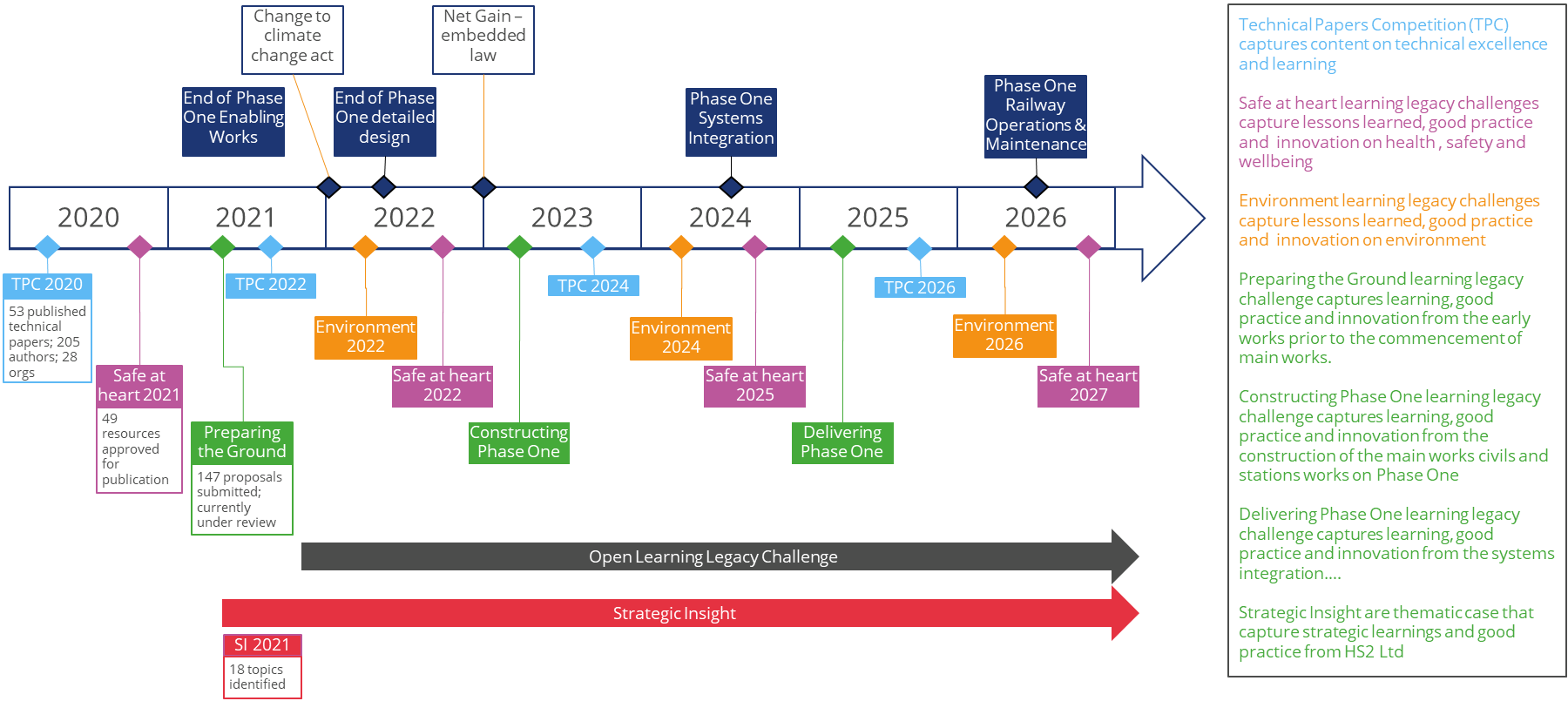
A comprehensive campaign of communications and engagement was instigated for each challenge and competition across the whole HS2 ‘family’ (client and all the supply chain). This included innovation hub communications, presentation at contractor and HS2 Ltd team meetings/events, adverts on the intranet and internal and supply chain newsletters, all to generate interest in participating in the Learning Legacy. Examples of the “Preparing the Ground” initial launch material and the author briefing presentation are provided as supporting documents to demonstrate how the authors were engaged. The author presentation was adapted to be used across a range of audiences such as individual teams, reviewers, senior sponsors supply chain to engage them with the process. A specific presentation was also developed on how to use the SharePoint Learning Legacy Challenge process and this was finessed as the system evolved.
To date there have been 5 completed challenges:
| Year | Challenge Title | Published Submissions | Challenge Theme |
|---|---|---|---|
|
2020 |
Technical Papers Competition 2020 |
49 |
Technical excellence from Design& Engineering, Environment and Digital |
|
2021 |
Safe at Heart |
28 |
Learning,good practice and Innovation on Health Safety and Wellbeing |
|
2021 |
Preparing the Ground |
34 |
Learning, good practice and innovation from the early works prior to the commencement of main works |
|
2022 |
Technical Papers Competition 2022 |
47 |
Technical Excellence from Design& Engineering, Environment and Digital |
|
2023 |
Construction and Safe at heart |
19 |
Innovations, lessons and best practice from the construction of Phase One with a focus of Health, Safety and Wellbeing |
A typical timeline for a formal challenge or Technical Paper Competition from the call for content to their publication is 8 months as per the steps shown in Figure 5.

The Technical Papers Competition (TPC) carried on the tradition set by Crossrail in publishing detailed technical papers on technical excellence and learning. TPC was effectively a formal Learning Legacy Challenge except the papers were also scored and the shortlisted papers independently judged by experts from industry.
An Open Challenge was set up to capture content outside of the formal challenge timeline and themes. This was added in order not to miss important knowledge capture which might easily be lost due to the pace of the project progress and /or key individuals moving on to other areas of the project or new organisations.
Strategic Insight captures client-side learning (i.e., how HS2 Ltd initiated, developed and delivered the project). This was similar to the way the London 2012 and Crossrail learning legacies were run with business sponsors/champions coordinating the learning from their departments, eg, PMO-led, procurement-led, etc.
Sponsorship and governance
The governance of the challenges was developed and implemented as shown in figure 6 below:

Each of the challenges, competitions and strategic insight had a business sponsor. Their role was to provide leadership and guidance to the Learning Legacy Team on the specific challenge.
Each challenge had a challenge panel chaired by the business sponsor and managed by the Learning Legacy Team. It was responsible for:
- Setting the challenge objective and approving the associated plan
- Championing participation in the challenge in the Business and Supply Chain
- Reviewing submitted Learning Legacy summaries for compliance with the challenge rules
- Identifying technical reviewers for each of the submitted resources
- Engaging with industry partners for dissemination of the learning legacy
- Oversight of communications and event planning
- Reporting progress to the Learning Legacy Oversight Panel
The Learning Legacy Oversight Panel is responsible for providing guidance and oversight of the Learning Legacy. It is chaired by a senior leader from the External Affairs Directorate and attended by senior members of the innovation, environment, health and safety, PMO and engineering directorates. It also has external involvement and is attended by a senior representative from the Institution of Civil Engineers. This has enabled the coordination of the Learning Legacy with the various knowledge-based activities being undertaken by each of these teams (eg, innovation challenges, lessons learned, etc) and breaking down traditional silos. Its terms of reference are:
- Learning Legacy Content – ensuring the right focus for learning legacy, monitoring its production and supporting review and approvals.
- Resources – ensuring an appropriate level of resource is available to deliver the learning legacy
- Coordination and promulgation of learning legacy including enterprise-wide (through existing forums such as Safe at Heart, Innovation Hub and the Environment Hub) and coordinating with industry-wide and Government knowledge sharing objectives
- Maximising beneficial use of learning legacy output by legacy owners (eg, other projects and bodies such as Health and Safety Executive, Environment Agency and Natural England)
- Oversight of communications of learning legacy by all parties
- Oversight of dissemination event plans
- Championing Learning Legacy across the programme and in industry
Submission process
A formal submission process was adopted in order to ensure papers were relevant and appropriate for the specific challenge. This is detailed in the workflow diagram in Figure 7.
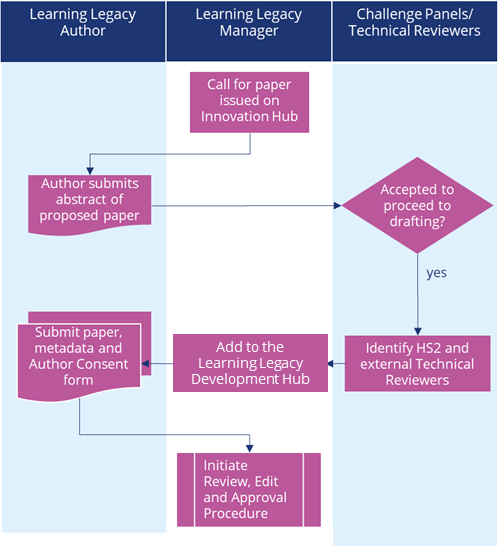
The initial call for content asks for 2-300 word summaries/abstracts to be submitted for review prior to proceeding to the drafting stage. All summaries are then reviewed by the Challenge Panel to confirm that it meets the three rules of the challenge/competition below or to provide steer on the content:
- Is the part of the project being discussed complete, i.e., the outcomes are known?
- Is the topic focused on HS2 and by people who have worked on HS2?
- Is it a Learning Legacy?
Subject to content meeting the above criteria, authors can then proceed to drafting.
When submitting their paper authors are also asked to provide the following metadata to aid discoverability and to coordinate with the metadata used by the Major Projects Association:
- Theme/Topic (from the Major Projects Taxonomy developed for previous learning legacy and hosted by the Major Projects Association[15])
- Free Tags
- Industry audience
- Knowledge Type
Authors are also required to sign a form for GDPR purposes to authorise use of their profile data on the Learning Legacy website.
Review
Peer review has been a feature in all learning legacies to ensure high quality and accurate content. At HS2, reviewers were a mix of internal HS2 and external subject matter experts. A Publication governance procedure[16] was developed to ensure the necessary author authorisations were in place and a clear and robust route to publication as shown in Figure 8.

Figure 8: Publication governance process
There are three types of reviewer for each learning legacy resource:
- A technical reviewer (internal or external) is a subject matter expert and is responsible for confirming the technical accuracy of the content. Information Asset Owners act as technical reviewers for approving publication of HS2 management system documents
- The Learning Legacy team is responsible for the editorial and ensuring the content meet the learning legacy requirements
- The Communications team is responsible for reviewing the content from a reputation management perspective and the final approval to publish.
Appendix 1 of the publication governance procedure[16] includes a workflow of the whole approval process.
All internal reviewers undertake a publication risk assessment against information security, commercial sensitivity and reputation risk which informs the final approval by the Communications team. Figure 9 below shows the criteria applied for the risk assessments and Figure 10 the detail of the High/Medium/Low rating given
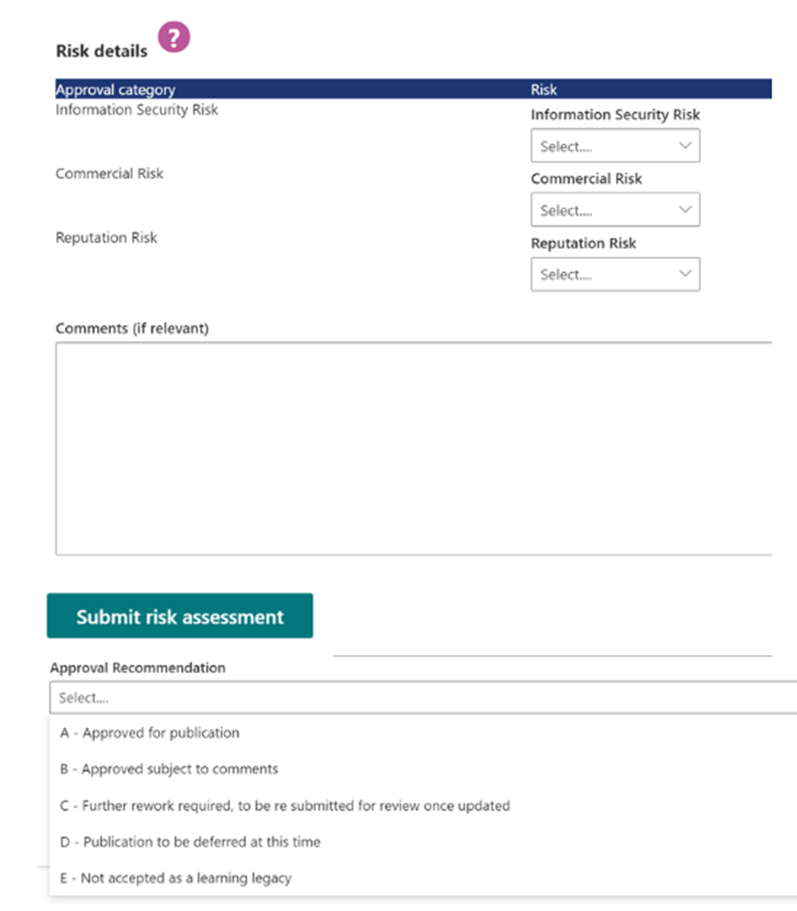
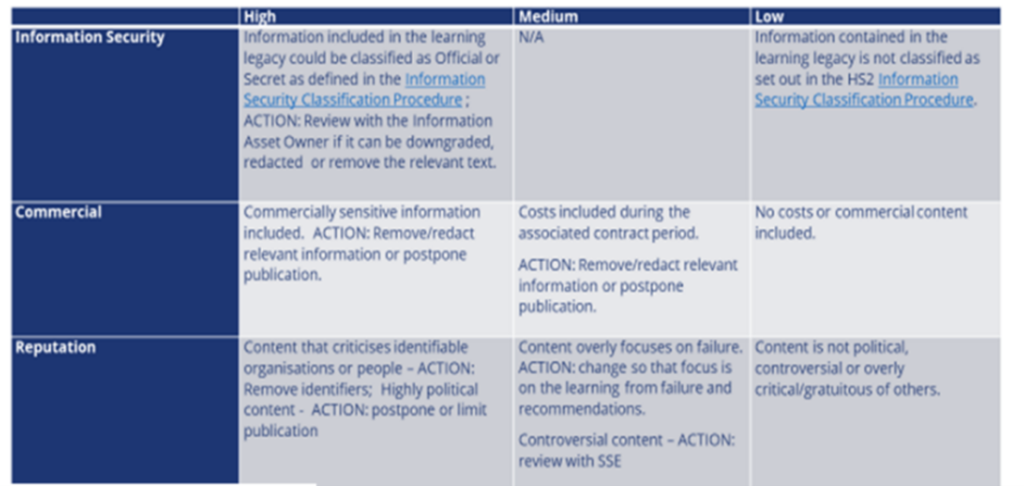
Organisation
At London 2012 and Crossrail, the Learning Legacy Team was 2 full time equivalents (FTEs) however the HS2 team was planned to be just 1 FTE hence the learning legacy process had to be as streamlined as possible.
The end-to-end content management system shown in Figure 11 was developed with resource efficiency in mind. The Innovation Hub on the Spigit platform was used as the start of the process due to its reach into the supply chain. The end of the process was a WordPress platform for the publicly accessible website (WordPress was used by the main HS2 website). WordPress wasn’t deemed suitable as a content management tool hence there needed to be a separate content management system.
SharePoint was chosen as the main content management tool and the Learning Legacy Development Hub was created as the central portal for submission of content and workflows for its subsequent review, edit and approval. This allowed access provision for the wider HS2 family and external technical /peer reviewers to the Learning Legacy SharePoint site as well as internal teams.
Using SharePoint ‘sandwiched’ between Spigit and WordPress meant a manual export of content from Spigit via a .csv file to SharePoint and a manual export out of SharePoint to WordPress. The export process was made easier by bulk exporting the metadata from SharePoint into a .csv file for import into WordPress to set up the website pages and then a mammoth .docx converter plug-in was used to import the document content.
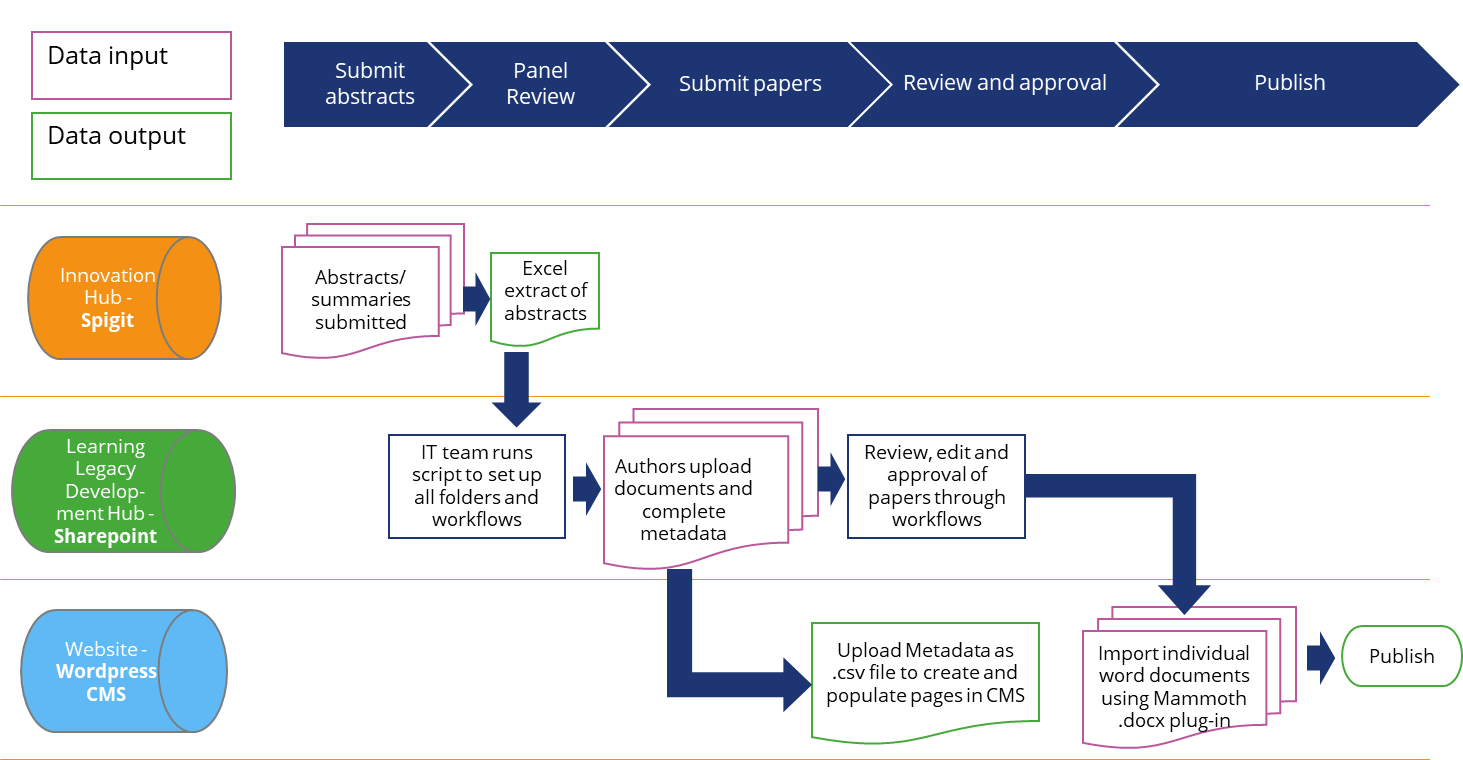
Publication
The Learning Legacy was published through the following means:
- Dedicated HS2 Learning Legacy website: https://learninglegacy.hs2.org.uk
- Printed media – books and industry journals
- Application Programming Interface (API) to share learning legacy automatically with other hubs.
Website
The HS2 Learning Legacy website was set up as a microsite from the main website as had been done before on Crossrail and London 2012. This allows for hiving off the Learning Legacy website after the HS2 project has finished so that it can be transferred to a legacy owner.
The website developed for HS2 was not significantly different than Crossrail or London 2012, but it had improvements in search engine capability and analytics as described below: –
Search Engine – the search capability of the HS2 Learning Legacy website was a key requirement of the brief. Previous experience of the Crossrail Learning Legacy was that it was slow with a poor level of discoverability. A Relevanssi search engine was applied to improve the discoverability of content and the speed.
Accessibility – The website was specified to meet W3 accessibility standards and was audited by the Digital Accessibility Centre, in line with the process used for the main HS2 website.
- Analytics – The use of analytics tools on the website enables the monitoring of who is visiting the site and how they use it. This helps to then direct future content and development of the site. The Learning Legacy website used e Matomo for analytics which was seen a good all-round alternative to Google Analytics because it has a good depth statistics reports but with real privacy customisation – ensuring compliance with General Data Protection Regulations (GDPR) while capturing sufficient data to properly measure the use of the Learning Legacy resources.
Printed media and industry journals
Following the precedent set by Crossrail, HS2 worked with the Institution of Civil Engineers (ICE) to publish the technical papers as a series of books[17]. Although the papers were all published on the website, the books served as an incentive for teams to document their work.
Application Programming Interface (API)
APIs are required for external organisations such as the Major Projects Association or other knowledge hubs to import the learning legacy content into the websites. Previously with London 2012 and Crossrail this was a manual process of exporting and importing a .csv file regularly.
On the HS2 project, a REST API plugin was used to create the interface and allowed the automatic update of content onto third party sites. This was successfully piloted by the Major Projects Association and all HS2 Learning Legacy content is now integrated into their knowledge repository.
Dissemination
Capturing and publishing the knowledge are key elements of the Learning Legacy process but ensuring that the knowledge is widely shared and promoted is just as important, if not more so. The key to this is the knowledge experts from the project, those that have created the content, or what is now known as the HS2 Learning Legacy Network.
Focus in previous learning legacies has been on sharing knowledge externally with industry rather than internally for the benefit of the project and this was initially the focus on the HS2 Learning Legacy. However, having started in the HS2 Learning Legacy so early on in the project lifecycle, it made sense to ensure that internal HS2 teams and the supply chain were included in dissemination activities, as well as the wider industry, and hence the measures of success was updated to reflect internal dissemination.
Internal dissemination
An internal communication and engagement programme was established to raise awareness and demonstrate the benefits of participating in the HS2 Learning Legacy. This included engagement with the internal HS2 teams and the Integrated Project Teams (IPT)/supply chain using internal communication channels. A set of promotional assets was developed that could be used internally and externally to raise awareness and signpost the Learning Legacy website and the internal Learning Legacy Development Hub. Examples such as this new animation video encouraging participation have been created: <insert link to animation>.
Once there was a significant number of resources on the Learning Legacy website, a schedule of podcasts on some of the key learning legacy submission topics have been planned with the authors, to share their learning across the organisation. Forums and meeting slots were also being identified at a senior level for the Learning Legacy Network to attend and share their knowledge.
Externally
The Learning Legacy Network is a valuable resource in enabling the knowledge to be actively shared externally, ie, beyond the project boundaries, through industry events, directly with other projects and also academia. This active engagement makes the knowledge more available and more likely to be utilised by others. Figure 12 shows these dissemination routes.
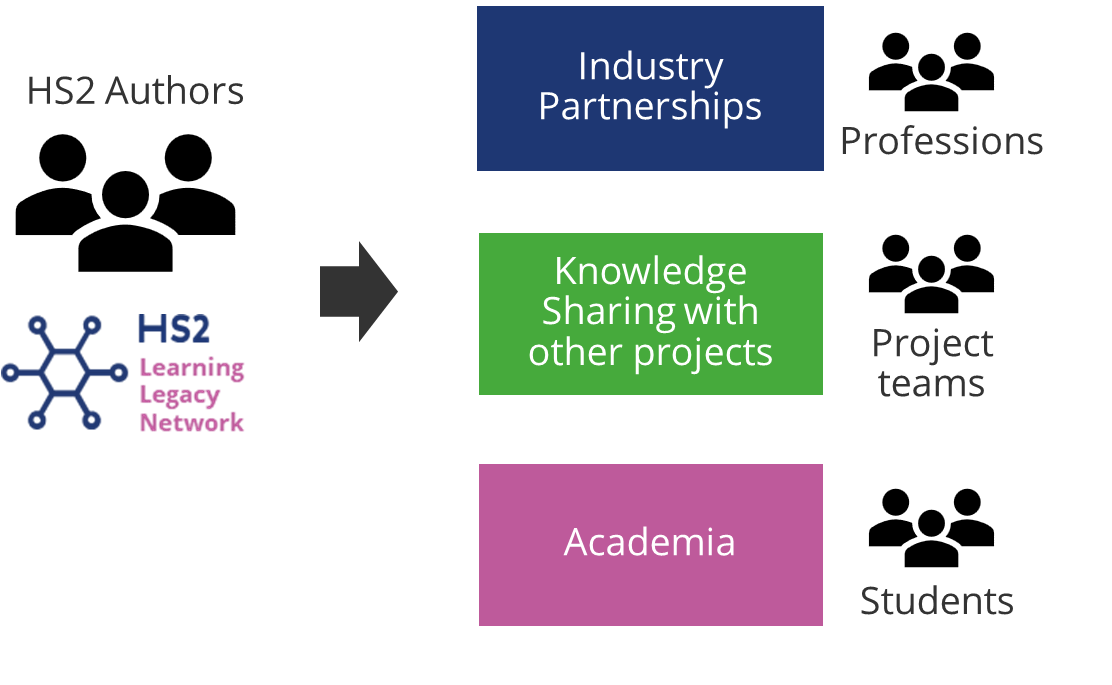
Learning Legacy network
All authors of a published Learning Legacy resource are invited to join the Learning Legacy Network. This means that they may be invited to contribute to external publications based on their learning legacy resource, eg, blogs and news articles. They also join the pool of speakers/participants for industry partner dissemination events.
Industry partnerships
Memorandums of Understanding (MOU) set out how HS2 will work with each industry partner and vice versa. These set the ground rules for the industry partners to work with the HS2 Learning Legacy Network to share the learning and good practice from the project. It also ensures that the dissemination events and feedback is captured to track the Learning Legacy impact.
Major Projects Knowledge Network – knowledge sharing with other projects
Knowledge sharing agreements with third party projects or organisations have been developed to share knowledge directly with other projects as part of a Major Projects Knowledge Sharing Network[18]. These are managed through a mutual NDA[19] and an associated Knowledge Sharing Procedure[20]. The NDA provides the secure means of sharing whilst the Procedure provides a structured approach to knowledge sharing between projects.
A key part of the dissemination is in identifying who this knowledge will be of interest to. A map of the upcoming rail and infrastructure projects identified in the Government Major Projects Portfolio is set out in Figure 13 below and this enabled the identification of the knowledge sharing agreements needed to ensure that future projects had ready access to HS2’s knowledge. The initial list of project organisations delivering the GMPP projects was identified as:
- Network Rail
- East West Railway Company
- Highways England
- Transport for London
- Transport for Wales
- Sellafield

This can be monitored and expanded as required, and potentially could become international.
Academia
Academic engagement is an objective of learning legacy. On London 2012 this was by supporting academic research and publishing plain English summaries of the outputs. HS2 already has established research frameworks through the UKRRIN[21] and UKCRIC[22] frameworks managed by the HS2 Innovation Team. Hence the HS2 Learning Legacy team consulted a number of universities to identify what their interest would be in the learning legacy which could then focus on the activity accordingly. The following benefits were identified:
- Case study material – a source of case studies which can be incorporated into course material
- Course participation, eg, Guest lecturers
- Source of interviewees for dissertation
The above however was limited to discussion on the published learning legacy material, with potential to expand to the wider business at a later date. This was captured in MOUs which was considered the best option to be able to manage the access.
Outcomes
Capture
- 186 resource pages published on the website (plus a number of supporting resources) including:
- 82 technical papers from the Technical Papers Competition (2020 and 2022)
- 38 insight articles/videos from the Safe at heart Learning Legacy Challenge
- 47 insight articles/videos from the Preparing The Ground (early works) Learning Legacy Challenge
- 19 insight articles/videos from the Construction and Safe at heart Challenge 2023
- 4 books capturing the technical papers, published by ICE Publishing
- 12 ICE Journal Papers – agreement by ICE to publish on the HS2 Learning Legacy website
- 250+ people across 30 organisations participated in authoring and sharing learning legacy content
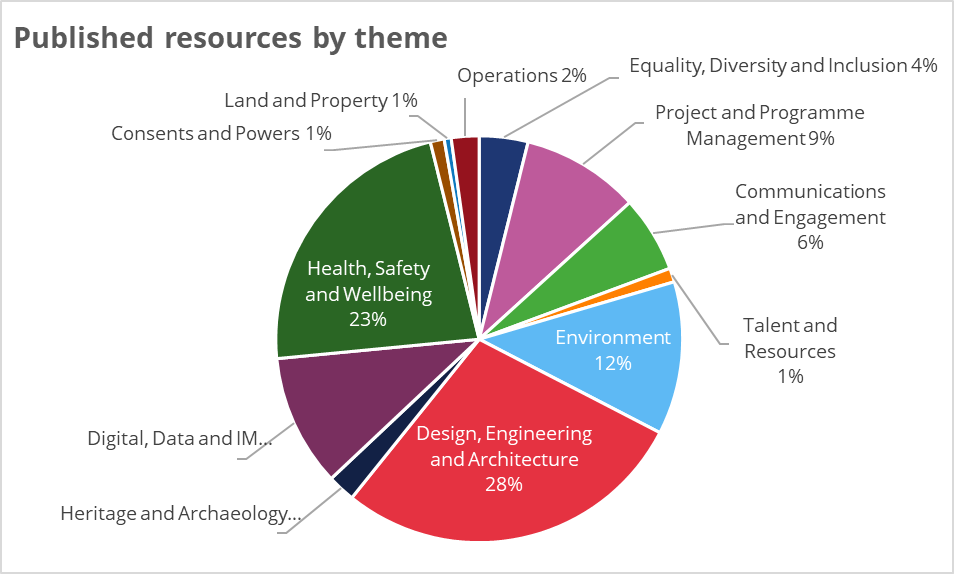
There was significantly greater engagement by supply chain. The CSjv (Enabling Works joint venture) Learning Legacy programme video and supporting content[23] demonstrates the committed supply chain engagement and how it was used to benefit their organisation. CSjv actually set up their own learning legacy team in order to coordinate submissions to HS2 but also to disseminate the good learning throughout their own organisation and to the SCS Joint venture organisation delivering the main works. The video submission shows how they did this and how the learning legacy was a springboard for learning internally. The Early Works Contract Transition Lead for CSJV sums up why they engaged so fully:
“The biggest challenges we face in our industry are often overcome collaboratively by different people over a long period of time. Producing a learning legacy paper is a brilliant way to professionally reflect on that journey, and share the collective learning with as many people as possible.” Ian McMillian Transition Lead CSjv
CSjv were very proud of their Learning Legacy contribution and have in fact used it as a promotional tool going forwards to demonstrate their achievements on the HS2 project.
From a main works prospective, SCS joint venture also found the Learning Legacy process beneficial
“For us, as part of the supply chain, The HS2 Learning Legacy is great on two fronts. First of all, having the resource there to feed improvement and learn from other contractors experiences is fantastic, particularly having it combined through the Major Project’s Association database so that people have one place to go to draw from several pools of knowledge. The fact that it isn’t waiting until the end of the project to be produced means we are seeing learning at a point where we might be able to make a change, rather than waiting for the next project to apply it. Secondly, and most importantly for me, it is a great tool to help us, as knowledge managers, encourage our own teams to share their knowledge now. The opportunity for industry recognition and the incentive from the client requesting the input, has driven our teams to record their learning where previously they may have learned locally and then carried on without sharing it further. It is a great opportunity for us to encourage that sharing at least once a year. We’ve promoted it through our internal communications but also on a one-to-one basis when we see something really good being achieved. We can encourage people to share their expertise and that opportunity provides a sense of satisfaction that their work is valued and is a huge motivator for us.” Danielle Pollok – SCS Project Knowledge Manager
All of the papers covering all the challenge themes to date can be found on the HS2 Learning Legacy website.
Organisation
How the organisation of the learning legacy has developed and evolved over the last ten years is shown in Table 2 below:
|
Major Project |
Learning Legacy Initiative |
First publication of content |
Organisation development |
|
London 2012 |
80% complete |
Substantial completion |
|
|
Crossrail |
60% complete |
70% complete |
|
|
HS2 |
2% complete |
20% complete |
|
The outcomes of this more structured Learning Legacy organisation for HS2 are:
- Setting up the Learning legacy and capturing the content from HS2 early in the programme, and encouraging supply chain participation, has enabled the very early learning to be captured which was not done before.
- Putting in more streamlined structured processes and timelines has led to the ability to manage increased content which, in turn, has led to an IT support resource being required to maintain the tool (eg, bugs and amends) and support each challenge set up.
- Developing an IT process to deal with the content capture ensures a robust governance process that is easily managed and enabled a clear route to publication approval.
Publication
The HS2 Learning Legacy website is the main vehicle for publication of learning legacy content. This was launched at an industry event in October 2021 chaired by Mark Thurston – then HS2 CEO, facilitated by Major Projects Association (MPA), and panel members from Infrastructure & Projects Authority (IPA), Sydney Metro and the ICE President with 100+ in-person and 367 online attendees.
At launch, the website hosted 100+ insight articles and videos. There are currently 186 and this content will l continue to grow throughout the life of the project.
Key statistics since the launch of the website in October 2021 to September 2023 are:
- 73,000 visits approximately
- 2000-3000 visits averaging per month.
- 40% of views are spread across the globe:
- 60% Europe
- 20% North America
- 16% Asia.
In terms of printed content, two volumes of technical papers were edited into two books, published by ICE Publishing[13] from the Technical papers competition launched in 2020. A further two, volumes 3 & 4, were published in November 2022 from the second competition published in 2022. Subsequent books will be published every two years to align with the Technical Papers Competition.
Content published by third parties using the HS2 API comprised the Major Projects Association which published all content on their Knowledge Repository resulting in HS2 Learning Legacy being the most visited content.
Dissemination
12 industry and professional bodies signed Memorandums of Understanding to become industry partners for the peer review and dissemination of the HS2 Learning Legacy.
Dissemination planning is underway with each partner to develop their plans for events and publication around the HS2 Learning Legacy content.
Two universities so far have signed MOUs for academic engagement with discussions currently ongoing with four more.
Knowledge sharing arrangements are in being set up with:
- Transport for London
- East West Rail
- Network Rail
- Transport for Wales
- Department for Transport (Northern Powerhouse Rail)
- Sellafield
- National Highways
Tracking insights
The follow measures were identified for tracking insights and behaviours of learning legacy users that could help measure the success of the learning legacy and inform its future direction:
- Participation in launch event, dissemination activities and technical challenges (quantitative measure)
- Number of authors, reviewers and moderators, number of event attendees
- Website analytics (quantitative measure)
- Number of visits and unique visits, geographical location of visitors, time spent on site
- Feedback surveys (qualitative measure)
- Website users, event attendees, other user surveys
- Case studies (qualitative measure)
- How is the Legacy being used by Government, industry, academics, and others?
- Link on the website banner to provide feedback on the Learning Legacy website
- Annual telephone survey to measure impact on the project community
Continuous improvement
The Learning Legacy continues to evolve and improve. There has been a real step change in people’s appetite to share their knowledge since London 2012 – in particular by the supply chain (tier 1). At London 2012 and Crossrail there was huge appetite by the client body and some involvement in the supply chain but nowhere near the level of engagement seen at HS2.
Another key step forward for Learning Legacy is the shift in focus from just one way sharing to reciprocal sharing. The HS2 Learning Legacy sought to set up knowledge sharing agreements with other projects to share HS2’s learning legacy but also to bring learning legacy into HS2. This structured approach to facilitating the flow of knowledge between major projects has huge potential to improve project performance and improve productivity across the construction sector and wider industry.
“The main benefits to HS2 in having a learning Legacy are in supporting a sense of pride in the project and organisation – showcasing the way it has raised standards in everything from the environment to H&S; supporting personal development and recognition for the individuals that have been authors or winners of Technical Papers Competitions in particular; ensuring that lessons are shared across the organisation and industry so that we can continue to learn from each other, continually improve, and spark further innovations” Iain Andrews – Learning Legacy sponsor, Head of Campaigns, Creative, Projects and Events, HS2 Ltd
Learnings and recommendations
Areas of learning from the HS2 Learning Legacy and recommendations for future learning legacies are detailed below, grouped under three areas – people process and tools.
1) People
- Business sponsorship is key to the success of an organisation’s Learning Legacy. Business sponsorship of learning legacy is essential in providing the leadership to encourage participation by teams as well as providing the expertise in shaping learning legacy challenges aligned to the business or industry need.
From the outset, the chair of the Challenge Panel (usually director level) supported by a panel of subject matter experts, and facilitated by the Learning Legacy Team, provided leadership for each learning legacy challenge on behalf of the business. At Initial briefings, the panel agreed the terms of reference and their role, making it clear that they were expected to champion the challenge across the HS2 family and provide support, knowing that they had senior backing. Getting this initial “buy-in” at high level was achieved by clear initial briefings between the Learning Legacy team and the sponsors.
Recommendation: Learning legacy challenges should be driven by the business, facilitated by the Learning Legacy Team
- Identifying key people to act as champions within their part of the project was key to driving participation.
Champions within the teams and supply chain are vital to raising awareness of the learning legacy opportunity and benefits and then championing participation within their teams and supply chain counterparts. This can be senior level champions such as members of the learning legacy challenge panels or knowledge managers and communications managers in the supply chain who can publicise and coordinate the learning legacy for their organisations.
On HS2, Challenge panel members were made up of the business sponsor, theme leads and supply chain representative and were expected to champion and encourage submissions from their teams and key suppliers.
Recommendation – engage theme leads to champion learning legacy from the client side and key people in the supply chain to champion it within their organisations
- Regular engagement, support, encouragement and nurturing were key to successful knowledge capture
To create an industry-wide resource the people in the organisation and throughout the supply chain need to be encouraged and nurtured at all stages, from initial abstract to full submission, to update with feedback, to final publication – there are many points at which the process can fail, and regular support and encouragement helps avoid this.
Scheduling briefing sessions and attendance at team meetings before the start of any challenge raised awareness initially within HS2 and put a “face” to the Learning Legacy team. This then encouraged authors/contributors to seek help and advice when required Author surgeries and 1-1 meetings at key points, such as halfway through and two weeks before submission dates to ensure any concerns /queries could be addressed.
Recommendation – plan in the time for engagement, help and support from the outset.
- From the outset the level of organisational participation needs to be allowed for.
- Individual departments need to be aware of time and commitment to participate
- Large pool of technical reviewers needed to review which, if internal reviewers, needs good management
- Awareness by and engagement with the Communications Teams is key for promotion required internally and throughout the wider organisation, both the client and supply chain comms teams
- Publication review time and resources when large numbers of documents submitted needs to be scheduled carefully
Briefing sessions, team sessions and general communications activity were all planned before launch of any challenge. Assistance from the Learning Legacy team continued throughout the challenge process with general surgeries and briefing sessions which could also be requested by individual authors. In parallel, as the challenge timeframe progressed briefings began for the technical reviewers to provide details and timeframes for the review process. The bigger the pool of reviewers the better, but also knowing what subject matter expertise was needed created better management of the reviewer resources. Finally, the communications team reviews were also scheduled in to ensure organisation sign-off. They needed to be pre-warned and briefed of the number of resources to be checked and timeframes required.
Recommendation: Factor in and create awareness of the time and commitment by various teams
- What’s in it for me (WIIFM)?
Being able to articulate the benefits of learning legacies to individuals is key to participation. Offering authors professional PR by being published in a book, on HS2’s website and speaking opportunities with industry partners is really valuable. Also being able to raise the team’s profile within the project and parent organisation, and the organisation’s profile in the industry is a really big incentive to encourage participation.
2) Process
- Forward planning of knowledge capture is important for resource planning and prioritisation
Reviewing the key programme milestones and identifying knowledge capture points and themes enabled forward planning of the Learning Legacy challenges to ensure that the knowledge could be captured at the right time before people have left the organisation and also enable allocation of resources and support within the business (senior support and encouragement). Forward planning provided teams with awareness and preparation time knowing that they could input to appropriate/specific challenges or setting up specific support to capture strategic insight from teams rather than doing via the challenges.
It was originally planned to run two challenges a year however this was re-focused to one a year. Forward planning the knowledge capture 5 years ahead meant that the Learning Legacy Oversight Panel could decide where the focus for knowledge capture should be, aligned to the programme lifecycle to provide best value for the industry.
Recommendation – plan knowledge capture aligned to the key programme milestones and then review alongside resource availability for prioritisation. Communicate the plan to manage expectations.
- Learning Legacy as contract deliverables encouraged good submissions.
Inclusion of Learning Legacy as a contract deliverable resulted in some good quality papers by the contract teams. If possible, plan to include this requirement when getting contractors on board. Include in client team objectives so it becomes “part of the job role” rather than an add-on. Another method to encourage submissions was to also introduce an element of “competition” regarding number of submissions between various teams/contractors.
- Resources and scalability
HS2 is a megaproject however the approach taken to delivering the HS2 Learning Legacy can be scaled down to smaller major projects as described with resource requirements below.
- Initial set up and soft launch of the learning legacy– at HS2 this was 1.1 FTE (an experienced specialist) for 12 months. A smaller organisation could use this learning legacy paper as guidance on how to set up their own learning legacy possibly with some strategic guidance from a specialist to support the process.
- BAU knowledge management resource – at HS2 this is 1 FTE which relatively small for the size of the project and would have even more impact at 1.5-2 FTE. For smaller projects 1FTE would be more appropriate or could be scaled down further to be part of another role such as in an existing knowledge management team or lessons learned team in the PMO.
- Publication – HS2 had a dedicated Learning Legacy microsite built however smaller organisations could just have a section of their main website to publish their own learning legacies. They can also (or instead of) share with the Major Projects Association via (API or direct sharing) to ensure that the learning legacy reaches a wider audience
- Dissemination – Because of the amount of content, HS2 set up industry partnership agreements to help them disseminate the HS2 Learning Legacy. However professional associations and industry bodies are always keen to publish and engage new speakers so direct engagement with these organisations to sharing learning legacies could be planned in just as easily.
Learning Legacy has historically focused on sharing learning with industry however the HS2 learning legacy did latterly start to think about sharing the learning internally. It is recommended that this be factored in at the start on future learning legacies and be coordinated with lessons learned activities which in all the learning legacies to date has been a separate (and somewhat siloed) activity.
3)Tools
- Uploading content to WordPress was time-consuming. A WordPress plug-in – Mammoth importer, was used to upload content to the website to avoid copy and pasting content however this was still a lot of work – it could be that better options are available. Although formatting was prescribed to enable easy upload to the web, a lot of work was required, mostly around images, to get the papers into a state suitable for upload to the web
Allow sufficient time and admin resource to do this.
- SharePoint workflows required ongoing IT support. SharePoint workflows provided robust governance and easier management however regular IT assistance was required to fix some of the bugs and to set up the initial workflows for each challenge. Recommendation: IT support for set up and ongoing support should be planned in.
Conclusion
The HS2 Learning Legacy has utilised the standard learning legacy framework and developed it into a more structured and robust product that uses current technology to improve efficiency.
With all the templates and procedures provided with this paper, any major project of any size can consider developing their own Learning Legacy with the knowledge of what is required, and the resource needed to implement and perhaps further develop the framework. As more projects do this the opportunity for internal and reciprocal learning expands and the project knowledge across the industry has an opportunity to grow and grow.
There are multiple benefits for both the organisation and the individuals who contribute:
- Reputation and professional profile of both can be enhanced
- Industry recognition and value
- Team building and collaborative working with an opportunity to celebrate the learning and good work
- Career development as it provides evidence for enhancement and qualifications
- It creates social value for organisation as it gives back to the industry by sharing with professional peers, organisations and via academia to the future industry champions
Opportunities for HS2 and future learning legacies are to collaborate more actively with the lessons learned team and other internal teams to ensure that learning legacy works to benefit the project as well as industry.
Does knowledge transfer through Learning Legacy help achieve the 35% improved project outcomes found in PMI’s[4] research? It certainly helps future projects by providing a useful resource of insight, good practice documents and templates, data and experts which when teamed up with industry bodies for engagement events and linked with other major projects for direct knowledge sharing has the potential to improve their outcomes – but how do you measure that at a project level? Becoming more effective at internal dissemination of learning legacy and coordinating the various related knowledge-based activities such as innovation, lessons learned and continuous improvement would further help achieve better outcomes.
By starting the Learning Legacy early at HS2, capturing as much learning as possible from the project has been enabled. By having the tools in place to share this knowledge widely there is, if utilised effectively, an opportunity for the whole industry to benefit.
Acknowledgements
Aileen Thompson – former Director of Communications and Stakeholder Engagement, HS2 Ltd
Safina Mirza – former Head of Campaigns, HS2 Ltd
Iain Andrews – Head of Campaigns, Creative, Projects and Events, HS2 Ltd
Bridget Badoe McQuick – Learning Legacy Manager, HS2 Ltd
References
[1] IPA (2020) Principles for Project Success
[2] HM Government (2022) The Construction Playbook : Government Guidance on sourcing and contracting public works projects and programmes.
[3] HM Government (2013) Construction 2025 Industrial Strategy: government and industry in partnership
[4] PMI (2015) Pulse of the Profession: Capturing the Value of Project Management Through Knowledge Transfer
[5] Elson K (2012) A Learning Legacy from London 2012 Accessed 5 September 2023.
[6] Morrell P (2011) Learning Legacy website Accessed 5 September 2023.
[8] Bennet S (2023) Managing the Crossrail Learning Legacy
[9] Major projects knowledge hub
[10] Thameslink Learning Legacy Accessed 5 September 2023.
[11] HS2 Learning Legacy
[12] HS2 Ltd (2020) Learning Legacy Policy
[13] HS2 Ltd (2020) Learning Legacy Framework
[14] Guidelines for Authors – Learning Legacy Challenge
[15] HS2 Ltd (2021) Major Projects Taxonomy
[16] HS2 Ltd (2022) Publication Governance Procedure version P02
[17] ICE publishing
[18] Elson K (2022) Activating the mycelium – sharing the hidden knowledge. Available at:
[19] Mutual NDA
[20] Reciprocal Knowledge Sharing Procedure
[21] UKRRIN – UK Rail Research and Innovation Network
[22] UKCRIC – UK Collaboratorium for research on infrastructure and cities
[23] CSJV Learning Legacy
Peer review
- Siohan MulcahyHS2 Ltd
- Howard SimpsonAssociation of Project Management


